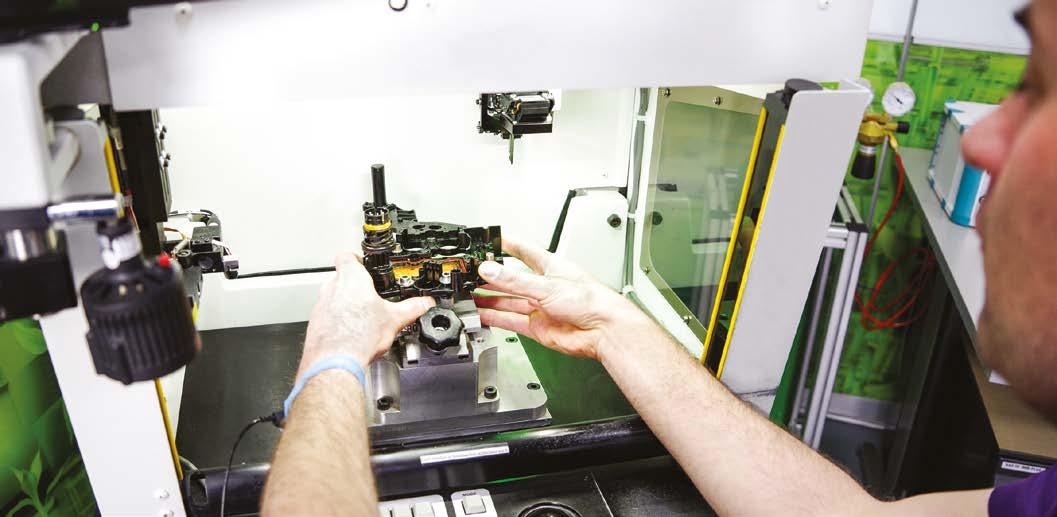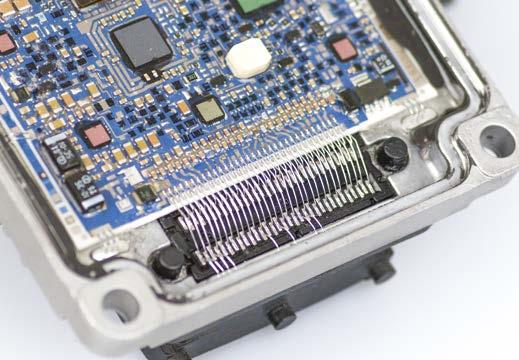
5 minute read
ACtronics: ECU issues & how to fix them
ECU issues and how to fix them
The ECU is truly a wonderful piece of engineering. Not only does it contain a lot of functionality, but to reliably operate in a harsh environment with very variable conditions is a big achievement. However, the reliability still leaves something to be desired every now and then. Why can’t they solve these weaknesses?
Advertisement
It might be useful to start with some elaboration about the technology that’s used inside an ECU. Of course, the basis is formed by a processor, memory and a PCB (Printed Circuit Board), but there is really much more to tell.
The PCB
We’ll start with the PCB itself: The well-known green printed circuit board, made out of fibreglass and epoxy resin, is still used regularly, but the arrival of ceramic material has made some manufacturers switch. Ceramic printed circuit boards can conduct and dissipate heat much better and are made of much finer and better structured material, which allows for very high precision manufacturing. This also has its advantages for printed circuit board design, as it also makes possible very small and complicated 3D structures. Car manufacturers are very eager to take advantage of these characteristics, as any form of space and weight saving is welcomed with open arms. We therefore expect to see the use of ceramic material in ECUs even more in the near future. by active components) dissipate quickly. Deformation and vibration therefore occur way less with ceramic printed circuit boards. It also prevents possible consequential damage due to these deformities. Cracks in solid connections are therefore also relatively rare. So, all-in-all, the use of ceramic material really has huge advantages. We even dare to say that the now somewhat older green printed circuit board is partly to blame for the varying reliability of some current ECUs.
Components on, and inside, the PCB
It should come as no surprise that this difference in printed circuit boards also results in a different use of components. A conventional printed circuit board has a coarser structure in comparison to the ceramic variant. The components themselves are therefore logically somewhat more "robust" in design. Most contact points are therefore large enough to be seen without a microscope. You would therefore think that these components are also more reliable than the smaller fragile components on a ceramic printed circuit board, but strangely enough, this theory does not seem to hold true in reality. The larger components still regularly fail. Could low manufacturing costs play a role in this?
Fortunately, with suitable (solder) equipment and sufficient skill, much is possible in repairing connections and replacing components on these conventional printed circuit boards, even if the contact points are located beneath the component, as is the case with processors such as BGAs. You’ll need special high-end equipment that can heat locally with extreme precision, but it’s doable for real experts.

An ECU with a modern ceramic printed circuit board.
becomes a lot more difficult. Because the overall design can be made smaller and more complex, it also becomes necessary to use smaller components. Fortunately, heat dissipation is not a huge problem due to the use of the ceramic material, even if these components are embedded. However, as soon as these delicate electronics fail, repair is not that easy. The components are difficult, if not impossible, to reach and they’ll damage quickly. In addition, the joints are often so small that they cannot be repaired without a microscope and some highly advanced equipment. It’s not impossible, but you must keep asking yourself in each individual case whether this is still economically justifiable.
Joint by wire
Speaking of joints, due to the compact and complex design of a ceramic PCB, solder joints aren’t the obvious choice. Manufacturers often resort to wire connections, which can be microscopic. For example, the wire connections that run from the PCB to the ECU connectors are clearly visible, but the hundreds of gold wires connecting the square purple component in the centre of the PCB are only 50 microns thick and therefore almost invisible to the naked eye.
Note: These small gold wires are an excellent example to explain why you should never touch components with your fingers: The probability of pressing these gold wires together and thus cause a short circuit is very high.
Let's be honest: These wire connections are clearly the weak spot of modern ECUs. They cannot withstand the continuous vibrations and temperature fluctuations for several years, circumstances that are common under the bonnet. This is mainly why a layer of silicone gel is applied, which should protect against this. However, this silicone gel does not prevent us from regularly encountering ECUs with faulty wire connections. And in our opinion, the chosen position of the ECU is also partly to blame. For example, on top of an intake manifold is not the most tactical position for a sensitive piece of technology such as an ECU. Yet some cars actually have the ECU placed right there! if you have the right (often expensive) equipment and use the correct methods. The thin aluminium wires cannot be soldered reliably, even if in theory there would be space for this option. But if soldering isn't the solution, how do you get these wire connections reattached to a contact point?
Ultrasonic wire bonding
A possible solution is to opt for ultrasonic wire bonding, as ACtronics have also done. As the name suggests, ultrasonic vibrations are used (frequency: 60 kHz) to make two metals (in this case the contact surface and the bonding wire) flow into each other. We won't go into too much detail, but we can tell you that this way of bonding takes place quickly, accurately and without the addition of heat. The technique is therefore particularly suitable for use around delicate components. In addition, the new joint is particularly strong: the result is comparable to a welded joint.
In short…
The shift to ceramic material has really benefited the ECU, as the older green circuit board has its drawbacks. Components appear to last longer due to better heat dissipation; solid connections suffer less from distortion and vibration and the design can be made much smaller, lighter and more complex. However, there is also a downside: wire connections. The ECU itself is by no means always to blame for the failure of these connections, but we cannot deny that this is clearly a weak spot. Fortunately, there are also companies such as ACtronics that have thoroughly studied this problem and can therefore provide a qualitative solution.
www.actronics.co.uk


